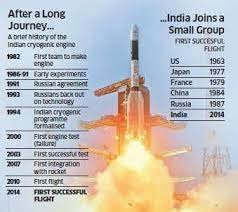Science and Technology
The
launch of Indian area analysis Organisation (ISRO)’s
much-anticipated fixed earth
observation satellite, EOS-03, resulted in AN unsuccessful mission when the GSLV’s refrigerant higher stage did not ignite in area and carry the payload to
its selected orbit.
What
is a cryogenic engine?
·
Cryogenic engines are typically very
powerful and carry liquid propellant at extremely low temperatures.
·
They area unit complicated however extremely economical and supply higher thrust for every metric weight unit of fuel burnt compared to the
normal solid and liquid propellant rocket stages.
·
Cryogenic engines were a vital a part of National physical science and area Administration (NASA)’s Phoebus Apollo missions to the moon, and were conjointly utilized by the GSLV for the
Chandrayaan-2 mission.
·
Only six countries have developed
their own cryogenic engines: the US,
France/European Space Agency, Russia, China, Japan, and India. Cryogenic engine
typically makes use of liquid oxygen (LOX), which liquifies at -183 deg C, and
liquid hydrogen (LH2), which liquefies at -253 deg C.
·
LH2 acts as the fuel while LOX acts as
the oxidiser that explosively reacts with the hydrogen, producing thrust.
·
When the engine ignites, the two liquids
are pushed into a combustion chamber by booster pump continuously.
·
ISRO’s cryo stage, called the C25, came
after the successful flights of the earlier versions developed for previous
GSLV launchers.
·
It was designed by the Liquid Propulsion
Systems Center, together with
Vikram Sarabhai house Centre,
ISRO Propulsion complicated and
Satish Dhawan house Centre.
C25’s tanks carry over twenty
seven,000 metric weight
unit of fuel and fireplace for about 720 seconds.
·
During this point, the engine develops a thrust of seventy three.55kN in vacuum. Impact
of failure of refrigerant engine
Missions like Gaganyaan and Chandrayaan-3 are launched on GSLV Mk-III, a additional advanced version of the GSLV rocket thats designed to hold a lot of heavier payloads into house.
·
GSLV Mk-III too uses AN indigenously-developed refrigerant engine within the higher stage, but, in contrast to the one in
Mk-II, this is often not
a reverse-engineered Russian engine.
·
Instead, the cryogenic engine used in
GSLV Mk-III, called CE20, has been the result of over three decades of research
and development, starting from scratch, and uses a different process to burn
fuel.
·
It is closer to the designs used in the
Arianne rockets that were used by ISRO earlier to send its heavier satellites
into space.


Comments